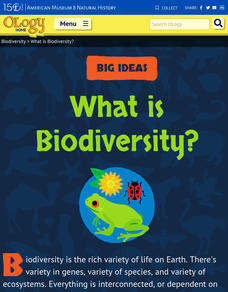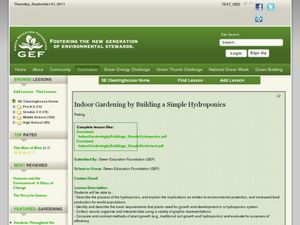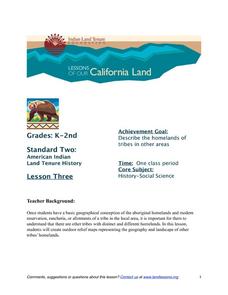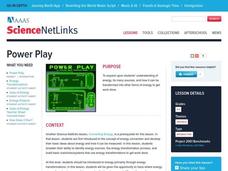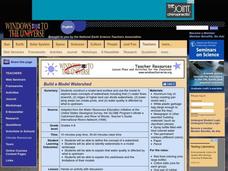Curated OER
Asthma and Allergies
Your health class reads two biographical stories: one about a girl who has allergies and the other about a girl who has asthma. They watch a quick cartoon on the KidsHealth website about immunity and take the related online quiz. You...
Polar Trec
Calorimetry Lab
Young people between the ages of 11–13 need on average about 2,000 calories per day. Within the lab, groups learn about calorimetry and respiration. They explore how it pertains to humans and animals living the Arctic where cold...
Desert Discovery
Saguaro Parts
Young biologists identify the basic structures of a saguaro cactus. They study the functions of each of the structures, and label them on a picture of a saguaro cactus embedded in the plan. This simple, and easy-to-implement...
National Nanotechnology Infrastructure Network
Creating and Testing Silver-Nanoparticle Socks
Antibacterial socks are a product of nanotechnology. An inquiry-based lesson asks collaborative groups to create their own antibacterial socks and then test them against other products on the market. The sock with the least amount...
Curated OER
Insects A-Z!
Alphabet insects! Who has ever heard of such a thing? Get ready because your class is going to research insects that start with a specific letter of the alphabet. In small groups, they'll use the Internet and reference texts to locate...
American Museum of Natural History
What is Biodiversity?
Not all dogs are the same just like not all finches are the same. An interactive online lesson helps individuals learn about the causes and limitations to biodiversity. The clickable sections describe the basics of the genetics of...
Curated OER
Test Your Speaking & Listening Skills: Lucky Dip 2
Sometimes your English language learners don't need structured speaking practice to build oral fluency. This fun trivia worksheet provides them several opportunities to talk. In groups, they must list three countries in Asia, three...
Curated OER
Indoor Gardening by Building a Simple Hydroponics
Young scholars investigate the use of hydroponic gardening on the world food supply. In this hydroponic gardening lesson, students make a garden out of a soda bottle, grow a cilantro plant, and compare hydroponics with regular gardening...
Indian Land Tenure Foundation
More Tribal Homelands
Here is a very fun idea that introduces young learners to how geographical location affects cultural development. They are introduced to four areas where Native Americans have lived in the past by reading stories and examining images....
Curated OER
Power Play
Once your physical science stars have a grasp of the different forms of energy, use this resource to get them putting the energy to work. Small groups choose from seven different project options and work together to build an energy...
Curated OER
School, Unplugged
What would school be like if you couldn't teach lessons that require technology? Would it benefit the class? Would it hold them back? Have your learners read this article and answer the basic reading comprehension questions. Then have...
Curated OER
Agriculture Shapes Kentucky History
Students explore the lives of early American Indians and settlers in Kentucky. They describe the agricultural practices of Indians native to Kentucky and develop a supply list for a group of settlers coming to the state to establish...
Curated OER
Test Your Speaking & Listening Skills: Lucky Dip 3
Group your English language learners for this fun trivia exercise. There are 20 questions for each group to discuss. They must name different animals that live in water, recall basic vocabulary terms, recall the capital of Russia, etc....
Curated OER
Semipermeable Membranes and Bioaccumulation
Beginning biologists place a drop of food coloring into water of differing temperatures to observe the effect on the diffusion rate. They remove the shells from raw eggs and then experiment with osmosis over the remaining membranes....
Curated OER
Build a Model Watershed
Collaborative earth science groups create a working model of a watershed. Once it has been developed, you come along and introduce a change in land use, impacting the quality of water throughout their watershed. Model making is an...
Teaching Heart
Proud To Be Me!
Another school year brings another group of unique and interesting learners into your classroom. Learn what makes these new kids tick with this questionnaire that asks for basic background and personal interest information.
Intel
Cell-to-Cell
The third in a series of 10 STEM project-based lessons focuses on cells types, functions, and physiology. Through research, discussions, writings, and presentations, groups learn about the difference between plant and animal cells, the...
Missouri Department of Elementary
Ingredients of a Relationship Recipe
An eye-catching hook makes a smart analogy between ingredients for a food recipe and ingredients for quality relationships. Scholars discuss and list qualities they feel contribute to positive interactions. Pupils create a recipe card...
Curated OER
What Would You Take to Sea? Instructions for Teachers
Students, who are teachers, discover the hazards facing sailors hundreds of years ago as they prepare a lesson to use in their classroom. They examine what each group of students will investigate, and how the findings will be discussed.
Curated OER
Food Pyramid
Second graders study nutrition and the food guide pyramid. They follow established procedures for use of programs :print in color only when directed, print only the number of copies directed by the teacher, select and use the programs...
Curated OER
Microwave Introduction
Middle schoolers take true and false pretest, and explore and practice basic principles of microwave cooking and how to use and care for it properly while preparing foods. Students watch teacher demonstration and then prepare their own...
Curated OER
The Lesson: Crises
Students take a closer look at world issues. In this current events lesson, students visit selected websites to study financial awareness. Students examine the credit crunch and the global food crisis.
Curated OER
Mathematics Through Nutrition
Students plan a meal including shopping, preparing and meal and serving it. They become aware of different foods from different ethnic backgrounds and describe the displays in the store and why the items are displayed as they are.
Curated OER
Strawberry DNA extraction
Students study the basic function of DNA and then extract it from strawberries. In this DNA extraction lesson students examine DNA and see why the extraction of it is so important to scientists.
Other popular searches
- Five Basic Food Groups
- Four Basic Food Groups
- 4 Basic Food Groups
- 5 Basic Food Groups
- Basic Food Groups Free
- 3 Basic Food Groups
- Basic Food Groups Worksheets







